AccessComputing: Building Capacity for Veterans (2009)
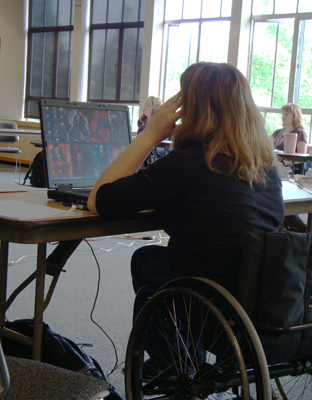
February 10 - 13, 2009
Seattle, Washington
A series of activities have been undertaken to increase the participation of veterans with disabilities in computing and information technology (IT) postsecondary education and career fields. These activities were coordinated by the Alliance for Access to Computing Careers (AccessComputing), led by the Department of Computer Science and Engineering, and DO-IT (Disabilities, Opportunities, Internetworking, and Technology) at the University of Washington (UW). AccessComputing is funded by the Computer and Information Science and Education program of the National Science Foundation (#CNS-0540615 and CNS-0837508).
AccessComputing institutional partners are Gallaudet University, Landmark College, and Rochester Institute of Technology. AccessComputing alliance partners are AccessSTEM, EAST, MIDWEST, RASEM2, National Center for Women and Information Technology, National Girls Collaborative Project, Commonwealth Alliance for Information Technology Education, Computing Alliance of Hispanic-Serving Institutions, Empowering Leadership: Computing Scholars of Tomorrow, and Advancing Robotics Technology for Societal Impact Alliance.
Goal and Outcomes
AccessComputing works to increase the participation of people with disabilities in computing and IT fields. AccessComputing collaborators apply evidence-based practices to:
- increase the number of students with disabilities successfully pursuing degrees and careers in computing fields
- increase the capacity of postsecondary computing departments to fully include students with disabilities in computing courses and programs
- create a nationwide resource to help students with disabilities pursue computing fields
- help computing educators and employers, professional organizations, and other stakeholders develop more inclusive programs and share effective practices nationwide
Capacity Building Activities
AccessComputing collaborates with project partners in a variety of ways:
- Conducting a Capacity-Building Institute (CBI) focused on increasing the participation of veterans with disabilities in computing and IT academic programs and careers.
- Sharing the results of the CBI with other institutions and individuals who serve veterans.
- Providing an electronic forum to continue discussion of veterans issues and increase services and supports for veterans.
- Extending resources to other programs and promising practices via an online searchable Knowledge Base.
Audiences for These Materials
This publication was created for people who:
- participated in the AccessComputing: Building Capacity for Veterans with Disabilities CBI
- want to conduct a CBI at their institution, in their region, or at a national or international forum
- seek to increase their understanding of issues surrounding the participation of veterans with disabilities in computing and IT studies and careers
- are motivated to join an electronic community to discuss these issues
- would like to access resources to help them make their campus courses, services, and activities more welcoming and accessible to veterans with disabilities
- have promising practices to share with others
About the CBI (AccessComputing: Building Capacity for Veterans 2009)
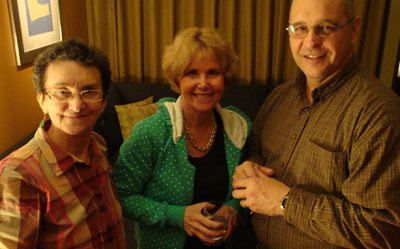
AccessComputing: Building Capacity for Veterans with Disabilities CBI took place February 10 - 13, 2009, in Seattle. Its overall purpose was to explore ways to increase the participation and success of veterans with disabilities in computing and information technology postsecondary studies and careers.
Participants in this two-and-one-half day event included student services leaders, administrators, and teaching faculty from institutions around the county. Hosted by the UW, the CBI provided a forum for comparing recruitment and access challenges, sharing successful practices, developing collaborations, and identifying systemic change initiatives for increasing the capacity of institutions to serve veterans with disabilities. Specific goals of this CBI were to:
- gain information about recruiting, serving, and retaining veterans on postsecondary campuses
- brainstorm ideas for bridging the gap between computing faculty, disability services faculty, and veterans services
- share information about best practices for serving veterans, funding opportunities, and resources
- network
Speakers and panelists were also CBI participants. Many were either veterans or practitioners with direct experience in serving veterans. Broad issues that were discussed included:
transition from military life to college life
recruitment and retention of veterans with disabilities in postsecondary education
education funding opportunities and military benefits
transition to employment after postsecondary graduation
In this CBI:
- all participants contributed to its success
- experts in all topic areas were in the audience and others visited via telephone and video conferencing technologies
- although some predetermined professional development was presented, new content was delivered as the meeting unfolded and participant interests were expressed and expertise was made known
The CBI was comprised of panel and individual presentations and working group discussions. Panel discussions offered participants opportunities to discover new ways for various veteran and campus disability services to collaborate to improve veterans' postsecondary experience. Individual presentations included information on the new G.I. Bill, computing and IT career opportunities for veterans, as well as best practices for institutions serving veterans with disabilities. Working group discussions allowed participants time to gather in small groups and discuss the following questions:
- What are the anticipated effects of the new G.I. Bill on our campuses? What are the characteristics of veterans returning to school?
- How can disability support services and computing faculty work together to effectively support veterans with disabilities?
- What types of services and supports can postsecondary institutions enhance or develop in anticipation of the needs of veterans with disabilities?
- How can schools partner with military bases and veterans organizations to improve the recruitment and support of veterans with disabilities into computing departments?
The agenda for the CBI, summaries of the presentations and panels, and reports from the working group discussions are provided on the following pages.
Agenda (AccessComputing: Building Capacity for Veterans 2009)
Tuesday
7:00 - 9:00 p.m.
Evening Social and Time to Get Acquainted
Wednesday
8:00 a.m.
Buffet Breakfast and Networking
9:00 a.m.
Welcome
- Institute objectives and schedule
- Introductions
- Project ideas
- Accessibility of the CBI
- AccessComputing: Goals, objectives, activities, and products
- Video Project
- Sheryl Burgstahler, AccessComputing Co-Director
10:00 - 10:45 a.m.
The New G.I. Bill: How Will It Affect Your Campus?
Pat Butin, Des Moines Area Community College
10:45 - 11:00 a.m.
Break
11:00 - 12:30 p.m.
Working Together: Disabled Student Services, Veterans Support, and Computing Departments
Panel:
- Florida State University
Bea Awoniyi, David Gaitros, Eric Lundblom - Georgia State University
Rodney Pennamon, David Smith, Teresita Warren - Green River Community College
Kelly Blackwood, Deb Casey, Michael Harris - University of Alaska
Mel Kalkowski, Pat Shepherd, Laura Winckler-Moore
Moderator: Sheryl Burgstahler
12:30 p.m.
Lunch and Working Group Discussion
Question 1: What are the anticipated effects of the new G.I. Bill on our campuses? What are the characteristics of veterans returning to school?
1:45 p.m.
Opportunities in Computing
Ed Lazowska, Department of Computer Science, UW
2:15 p.m.
Interventions, Minigrants, and Other Opportunities
Sheryl Burgstahler
2:45 p.m.
Break
3:00 p.m.
Working Group Discussion
Question 2: How can disability support services and computing faculty work together to effectively support veterans with disabilities?
4:15 p.m.
Working Group Reports
Working group representatives each deliver a three-to-five minute summary of their group's discussion and accomplishments.
4:45 p.m.
Preview of Tomorrow's Agenda, Daily Feedback
Complete daily feedback form.
5:00 p.m.
Adjourn
6:30 p.m.
Dinner, Networking, and Discussion of Future Collaborations
Thursday
8:00 a.m.
Buffet Breakfast, Networking, and Discussion
9:00 a.m.
From Field to Family: Our Perspective
Steve and Lisa Tice, MHN Health Net
10:00 a.m.
Best Practices: Higher Education Consultation and Outreach
Peter Schmidt, Washington Department of Veterans Affairs
11:00 a.m.
Break
11:15 p.m.
Military Cultural Competence
Scott Swaim, Valley Cities Counseling
12:00 p.m.
Post-Traumatic Stress Disorder on Campus
Scott Swaim, Valley Cities Counseling
12:30 p.m.
Lunch and Working Group Discussion
Question 3: What types of services and supports can postsecondary institutions enhance or develop in anticipation of the needs of veterans of disabilities?
1:40 p.m.
AccessComputing Internships for Students and Veterans
Scott Bellman, AccessComputing and DO-IT Coordinator/Counselor
1:45 p.m.
Lessons Learned: Job Placement and Transition into Civilian Careers
Retired Major General James Collins
2:45 p.m.
Break
3:00 p.m.
Disability and Computer Science: Statistics and Issues
Richard Ladner, AccessComputing Co-Director
3:45 p.m.
Putting the Pieces Together: Assistive Technology and Accessible Design
- Assistive Technology
Dan Comden, Access Technology Lab Manager, UW - Accessible Design
Terry Thompson, Technical Specialist, AccessComputing - Applied Technology
Donald Parks, Applied Information Technology
4:45 p.m.
Preview of Tomorrow's Agenda, Daily Feedback
Complete daily feedback form.
5:00 p.m.
Adjourn
Friday
8:00 a.m.
Buffet Breakfast, Networking, and Discussion
9:00 a.m.
Overview of Agenda
Sheryl Burgstahler
9:30 a.m.
Universal Design
Sheryl Burgstahler
9:45 a.m.
The Healing Effects of Education
Bridgett Cantrell, Hearts Toward Home International
Pat Shepherd, Fort Richardson
11:00 a.m.
Break
11:15 a.m.
Working Group Discussion
Question 4: How can schools partner with military bases and veterans organizations to improve the recruitment and support of veterans with disabilities into computing departments?
12:00 p.m.
Lunch and Collaborative Meeting Evaluation
Complete post-test and place in the evaluation box.
Participants (AccessComputing: Building Capacity for Veterans 2009)
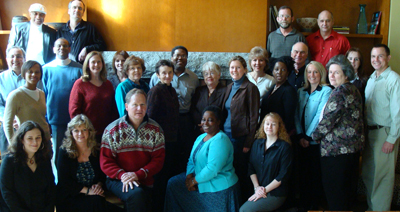
Stakeholder groups represented in the CBI included:
- student services leaders and administrators
- computing faculty
- technology specialists
- individuals working for veteran-serving organizations
- veterans
The following individuals participated in the CBI:
Anderson, Alice
Coordinator, Technology Accessibility Program
University of Wisconsin-Madison
alice.anderson@doit.wisc.edu
Awoniyi, Bea
Assistant Dean of Students
Florida State University
bawoniyi@fsu.edu
Bechtol, John
Assistant Dean of Students
University of Wisconsin-Madison
bechtol@wisc.edu
Bellman, Scott
Program Coordinator, DO-IT
University of Washington
swb3@u.washington.edu
Bittner, Sharon
Director, Academic Support Services
Des Moines Area Community College
sgbittner@dmacc.edu
Blackwood, Kelly
Consultant, Human Resources
Green River Community College
kblackwood@greenriver.edu
Burgstahler, Sheryl
Co-Director, AccessComputing
Director, DO-IT University of Washington
sherylb@u.washington.edu
Butin, Pat
Coordinator, Veterans Services
Des Moines Area Community College
pbutin@dmacc.edu
Butler, Ernie
Executive Director
Paralyzed Veterans of America NW Chapter
email4ebutler@aol.com
Cantrell, Bridget
CEO, Hearts Toward Home International
Cantrell Counseling & Hearts Toward Home International
inquire@heartstowardhome.com
Casey, Deb
Dean, Student Services
Green River Community College
dcasey@greenriver.edu
Comden, Dan
Assistive Technology Consultant
University of Washington
danc@washington.edu
Courtney, Joyce
IT Policy & Office Manager
Missouri Southern State University
courtney-j@mssu.edu
Crawford, Lyla
Program Coordinator, DO-IT
University of Washington
lylac@u.washington.edu
Crippen, Marvin
Technology Specialist, DO-IT
University of Washington
mcrip@washington.edu
Elimelech, Judy
Coordinator, Disability Services
Missouri Southern State University
elimelech-j@mssu.edu
Gaitros, David
Director, User Services
Florida State University
dgaitros@fsu.edu
Hanebutte, Shema
Manager, Advising & Counseling Center
Clover Park Technical College
shema.hanebutte@cptc.edu
Harris, Michael
Administrative Assistant
Green River Community College
mharris@greenriver.edu
Hayman, Doug
Technology Specialist, DO-IT
University of Washington
dhayman@u.washington.edu
Kalkowski, Mel
Director, Military Programs
University of Alaska-Anchorage
anmlk@uaa.alaska.edu
Killen, Michael
Senior Benefits Officer
Paralyzed Veterans of America-NW Chapter
michaelk@pva.org
Ladner, Richard
Professor, Computer Science
Co-Director, AccessComputing
University of Washington
ladner@cs.washington.edu
Lazowska, Ed
Bill & Melinda Gates Chair, Computer Science & Engineering
University of Washington
lazowska@cs.washington.edu
Lundblom, Eric
Readjustment Counseling Technician, Vet Center
Florida State University
Eric.Lundblom@va.gov
Miller, Lori
Counselor/Faculty
Seattle Central Community College
loriannmiller@earthlink.net
Mog, Ashley
Program Assistant, DO-IT
University of Washington
amog1@u.washington.edu
Parks, Donald
President/CEO
Applied Technology, Inc.
CEO@AppliedTechnology-US.com
Pennamon, Rodney
Director, Disability Services
Georgia State University
rpennamon@gsu.edu
Schmidt, Peter
Contractor/Sr. Associate Dean
Washington Department of Veterans Affairs and Edmonds Community College
peter.schmidt@edcc.edu
Shepherd, Pat
Director, Army Education & Libraries
Fort Richardson
patricia.shepherd@richardson.army.mil
Smith, David
President, Metro Atlanta Chapter of the National Association for Black Veterans
Georgia State University
smithdavidjr@hotmail.com
Souma, Al
Counselor, Disability Support Services
Seattle Central Community College
asouma@sccd.ctc.edu
Stewart, Lisa
Program Coordinator, DO-IT
University of Washington
lstew2@u.washington.edu
Sundby, Valerie
Coordinator, Disability Services
Clover Park Technical College
valerie.sundby@cptc.edu
Swaim, Scott
Director
Valley Cities/WDVA
scottswaim@milspecvets.com
Thompson, Terry
Technology Accessibility Specialist, AccessComputing
University of Washington
tft@u.washington.edu
Tice, Lisa
Counselor and Consultant
MHN Health Net
sltice@comcast.net
Tice, Steve
Counselor and Consultant
MHN Health Net
sltice@comcast.net
Warren, Teresita
Cognitive Disability Specialist
Georgia State University
distw@langate.gsu.edu
Winckler-Moore, Laura
Adaptive Computing Lab Manager, Disability Support Services
University of Alaska Anchorage
anlsw1@uaa.alaska.edu
Presentation Summaries (AccessComputing: Building Capacity for Veterans 2009)
Below are summaries from the CBI small group discussions.
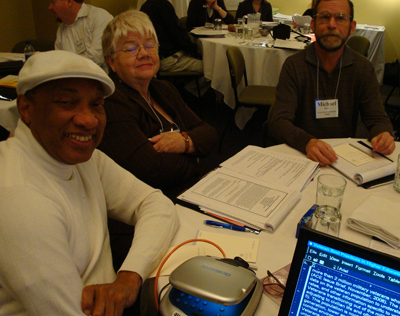
The New G.I. Bill: How Will It Affect Your Campus?
Presenter: Pat Outing, Des Moines Area Community College
Information regarding the new G.I. Bill has been subject to frequent updates and amendments. The federal government maintains up-to-date information about the bill at http://www.gibill.va.gov/.
The new G.I. Bill is also known as the post-9/11 Montgomery G.I. Bill or Chapter 33. It is very different than the previous G.I. Bill. Information about the new bill available at the time of the CBI suggests that each veteran on your campus may be entitled to different benefits according to length of service. Given that the benefits will vary for each student veteran, the administration of funds under the new bill may require increased administrative training and oversight. Institutions have until August 1, 2009, to develop a plan for implementation and administration of benefits.
Active duty service personnel will automatically be enrolled in the new bill. Service personnel who were already enrolled under the old bill may have a choice about which benefits to access.
The maximum tuition benefit covered under the new bill may be that of the most expensive public college or university in the state. It may also include a housing allowance that is based on the cost of living in the zip code area in which the school is located. Additionally, as of 2010, veterans' benefits will no longer be considered when determining eligibility for federal financial aid.
Under the new bill, tuition will be paid directly to the institution. One challenge may occur if a student drops a class or reduces his or her course load after tuition has been paid; in this case, the institution would typically refund the tuition dollars directly to the student. If this occurs under the new bill, it would be the responsibility of the student to return the refund to the Veterans Administration. This system could create confusion for students and/or jeopardize their eligibility to continue in school.
Opportunities in Computing
Presenter: Ed Lazowska, Department of Computer Science, University of Washington
Dr. Lazowska shared background information on the field of computing, how it has advanced, and opportunities that exist for students with disabilities, including veterans, in computing and IT careers.
He described how computing advancements have shifted how we live, work, learn, and communicate. Advances in computing have aided the progress of research in other disciplines, powered our economy, and changed how business is conducted.
The impact of IT in a wide variety of fields is continually increasing. Specifically, developments in robotics have enhanced the ability of people with disabilities to function independently. However, there are many IT problems yet to tackle. These outstanding issues will create new opportunities for careers in computing. In Washington State, computing jobs constitute five of the ten fastest growing fields and are the highest paid jobs in these high growth fields. The vast majority of all new jobs in engineering are going to be in computer science and, therefore, students who are trained in computing will be highly marketable.
Computing fields are much broader than people often think. There is more to computing than programming. People who are trained in computer science pursue diverse careers in which they apply their relevant skills. Two out of three computing jobs are not for IT producers like Microsoft or Google, but rather in businesses, banks, and other organizations. Working in the computing industry can be creative, interactive, and empowering.
The importance of diversity in computing fields is beginning to be recognized. Currently, the majority of people in the field are white males who don't always address the variety of cultural interactions with technology. A diverse workforce, including people with disabilities, produces better products because more perspectives are addressed in their development.
From Field to Family: Our Perspective
Presenters: Steve and Lisa Tice, MHN Health Net
Steve and Lisa Tice shared their personal story of the transition they experienced when Steve arrived home from the Vietnam War. Their presentation increased audience awareness of the daily struggles that veterans may face. Many issues that recent veterans face are similar to those faced by veterans of past wars. It may be helpful for the families of recent veterans to hear the stories of other families who have been through similar situations.
The ABC Nightline interview, "Star of the Family," illustrates Steve and Lisa's story. Steve served in the Vietnam War and was severely injured. When he returned home, Steve struggled to be a "regular person." He married Lisa, had a child, and went to college but his adjustment was difficult. He and Lisa shared their story of coping with post-traumatic stress disorder (PTSD), physical injuries, and adjustment issues. They shared issues that many families cope with such as anger, pain, and abuse.
Steve and Lisa noted that some injuries from current conflicts are different than those of previous wars. New medical advances mean that more soldiers are surviving battle injuries that previously would have been fatal. Many soldiers are returning home with brain injuries, spinal injuries, blindness, and amputations.
They also mentioned that understanding unique stressors facing veterans' families is important. Many families are facing multiple deployments and relocations, which uproots them from their community.
Online resources recommended by Steve and Lisa for veterans and their families include:
Best Practices: Higher Education Consultation and Outreach
Presenter: Peter Schmidt, Washington Department of Veterans Affairs
Peter Schmidt discussed best practices for serving veterans in postsecondary education. He suggested that the most important thing an institution can do is ensure that faculty are prepared to work with students who arrive in the classroom with a diverse set of experiences.
Some of the ways that campuses can become more veteran-friendly are to:
- develop a veterans association or club to provide a gathering place for veterans
- listen to veterans and include them in the dialog about the issues they face on campus
- build a monument to honor veterans and show that the campus is veteran friendly and aware of veterans' issues
- remind faculty to be sensitive to veteran issues when they choose examples to share in the classroom
- assess the strengths and weaknesses of the institution, including what resources are available for veterans and how information about those resources is communicated
- create a veterans resource team
- pay attention to terminology used in reference to the team; for example, using "counsel" versus "support" terminology may be better received by veterans
- include resources for veterans in the main college catalog or guide
- provide campus resource information in local veterans centers and hospitals
- publish websites to reach out to young veterans
Military Cultural Competence
Presenter: Scott Swaim, Valley Cities Counseling
Scott Swaim noted that an important aspect of serving student veterans effectively is to understand the culture that exists within the military. Many student veterans, especially those recently discharged from the military, are used to living within a very structured environment. An understanding of this culture as well as military traditions can help to ease the student veteran's transition to campus life.
A few important things to remember are:
- There is an instant bond between veterans, even between those who served in different branches of the service and in different wars;
- Some language that may be considered unacceptable on campus is commonly used in military life;
- Time commitments in civilian life are very different and less structured than in military life;
- Rank structure is very important and veterans are used to knowing who is in charge and who to go to for answers and direction;
- "Battle mind" is very different than "home mind" and the things that kept soldiers alive in battle are the same things that often keep them from reintegrating effectively at home.
To learn more about military life and culture, postsecondary staff and faculty can attend civilian orientation days at their local military base. Other resources include the Veterans Administration (VA) and Vets Centers. Find your local VA facility by visiting www.va.gov/directory/guide/FindLocations.cfm.
PTSD On Campus
Presenter: Scott Swaim, Valley Cities Counseling
There are many things to keep in mind when working with veterans with PTSD, including the following:
- Individual experiences are unique to each veteran. When counseling, keep in mind the range of experiences that each veteran may have had in the military;
- Remember that mental health issues are not always addressed in the military;
- Understand that spouses and children are also affected by military service. Specifically, be aware of family impacts and stressors associated with PTSD;
- Provide community and other support to veterans and their families through networks with local veterans organizations and other campus resources.
Lessons Learned: Job Placement and Transition into Civilian Careers
Presenter: Retired Major General James Collins
Veterans leave military service with a wide range of skills and experience that may be useful to them in civilian careers. However, many struggle to find employment that is suitable to their personalities, skills, and interests.
Several ways of helping veterans gain employment include the following:
- Teach veterans how to develop a strong network. Discovering satisfying employment opportunities is easier with a large network of people who know your skill set and career interests;
- Do not duplicate or replicate the efforts of other groups on your campus. Instead, discover what activities other groups are doing and develop a partnership with them that will increase the effectiveness of activities;
- Provide a listing of internship opportunities for student veterans. Internships are a great way for them to gain experience in their fields of interest and may lead to permanent employment opportunities;
- Create mentoring opportunities for student veterans. This will allow them insight into the culture and skill requirements for the career fields they are pursuing. It may also create opportunities for networking;
- Promote the qualities of veterans that make them excellent employees, including experience in their specialty, leadership skills, diversity of experience, teamwork and team building skills, and work ethic;
- Encourage companies to identify veterans in the hiring process and educate job recruiters on how to translate military service into job experience and skills.
Universal Design
Sheryl Burgstahler, AccessComputing
Universal design is a design strategy that addresses the diverse abilities and other characteristics of potential users of a product or environment. When applied, products and environments are usable by the broadest range of individuals without special adaptations. Suggestions for applying universal design to technology, instruction, services, and physical spaces were presented. These suggestions included:
- Separate entrances can segregate people with disabilities. Ideally, individuals with and without disabilities should use the same entrance;
- Make signs descriptive and appropriate. Find ways to use language that is inclusive;
- In images on websites and brochures, include people with diverse characteristics with respect to race, gender, age, and disability;
- Provide multiple modes of content. For example, consider providing a text document to accompany audio content;
- Provide work surfaces that are adjustable or that vary in height;
- Prepare all staff to work with all participants by offering training in universal design;
- Consider making more accessible facilities and classes;
- For more information about the application of universal design within postsecondary institutions, consult the Center for Universal Design in Education.
AccessComputing offers funding for minigrants for events that support AccessComputing objectives, including the application of universal design. Visit Apply for an AccessComputing Minigrant for more information.
Reports from Panel Discussions (AccessComputing: Building Capacity for Veterans 2009)
Panel—Working Together: Disabled Student Services, Veterans Support, and Computing Departments
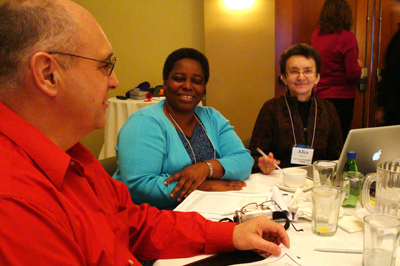
Staff from Florida State University, Georgia State University, Green River Community College, and University of Alaska-Anchorage shared information about their programs and activities that support veterans, particularly those with disabilities. Panel members recommended the following campus activities for creating a welcome environment for veterans:
- Create a Veteran's Coordinating Council that includes staff, faculty, and administrators. This council can explore how to make campus services relevant to veterans, including disability support services, recruitment, registration, and student services. This group may organize various events for veterans.
- Develop campus programs specifically for veterans (e.g., Veterans Conservation Corps) to facilitate networking with each other and the larger campus community.
- Post "vet friendly" signage in offices on campus to let veterans know in which offices they can find personnel who are sensitive to and knowledgeable about veteran's issues.
- Create and distribute a veteran's coin designed specifically for your campus. Collaborate with veteran students, faculty, and staff to help with the design of the coin. Assistance may be available from your local Veterans of Foreign Wars (VFW) chapter.
- Make it clear to all students and staff that supporting veterans is about supporting people and families, not about individual political viewpoints.
- Plan activities to recognize and celebrate Veterans Day.
- Work toward institutional change by involving high-level administrators in planning.
- Engage with veteran's groups at other local campuses to share ideas and resources.
- Apply for funding from outside sources, such as an AccessComputing mini-grant, to host a CBI on your campus to assess the needs of student veterans and plan activities.
- Involve community agencies, such as vets centers, in campus events and committees.
- Start a veterans student group to focus on the social aspects of campus life and to build camaraderie.
- Design a website dedicated to veteran issues and resources. Post a prominent link to the site from the college's homepage.
- Provide coaching to new student veterans on how to access services on campus and gain academic skills necessary to succeed in postsecondary education.
- Form a veterans learning community. The student veterans in the community could attend orientation together, take the same classes, and connect with mentors. Provide training for faculty on traumatic brain injuries (TBIs) and PTSD and how these conditions may impact students.
- Create and distribute a list of activities that may cause problems for some veterans, such as using a laser pointer in a dark room.
Panel—The Healing Effects of Education
Bridgett Cantrell, Hearts Toward Home International
Pat Shepherd, Fort Richardson
Participation in postsecondary education can play an important role in mitigating many of the effects caused by injury and trauma that result from deployments into conflict areas. Learning new things in the classroom and developing career goals as part of the school experience can help veterans look to the future with hope and excitement. Some of the points presented by panel members are summarized below:
- Ask and thank student veterans for their service—many people are touched in some way by people who have served in the military.
- Seek linkages and provide services to family members of student veterans.
- Don't pathologize or normalize symptoms, as some of them are survival skills.
- Our culture, unlike some other cultures, is missing rituals to welcome home warriors. There is no format for storytelling and healing after war. Facilitate storytelling in classrooms and communities. One option is to have a discussion in class about military issues. Invite student veterans to self-disclose and tell the class about their experiences in the service.
- Returning soldiers are less likely to access disability services and to otherwise self-identify as having a disability than other students with disabilities.
- Every returning soldier is changed by his or her experiences. For example, many deal with sleeping issues. It is important to look at veterans as individuals to identify their unique needs for accommodations and general support.
- Suicide is becoming more salient with returning soldiers. Many are able to mask feelings, adapted from skills needed to be a warrior. Interpret non-verbal communication as best you can and maintain linkages with counseling opportunities.
- Some veterans experience or perceive stigmas related to seeking or receiving health care on campus. Normalize self-care as an important skill for all students.
- Connect to education services counselors on military bases. They may be able to help translate military service into school credit. Ask about remediation programs and academic testing centers to help soldiers prepare for outside education.
Reports from Working Group Discussions (AccessComputing: Building Capacity for Veterans 2009)
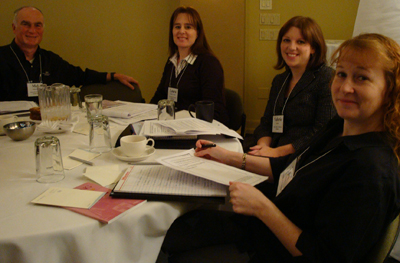
CBI participants represented a wide range of stakeholder groups, including postsecondary faculty and staff, employees of veterans-serving organizations, and veterans. They came together to brainstorm ideas for serving veterans in postsecondary education in general, and, specifically, to encourage veterans with disabilities to pursue computing and IT careers. Their discussions are summarized below.
Question 1: What are the anticipated effects of the new G.I. Bill on our campuses? What are the characteristics of veterans returning to school?
It is anticipated that there will be increasing numbers of veterans with disabilities on our campuses. Common disabilities include TBI and PTSD, amputations, and sensory impairments. Greater numbers of student veterans are attending two-year rather than four-year schools.
Veterans returning to school, especially those with disabilities, often:
- are facing challenges in adjusting to civilian life
- deny or minimize the impact that their disability has on their learning
- want to fit in and be "normal"; are unsure of what academic field will be a good fit with their skills, interests, training, and talents
- fear failure
- are frustrated with trying to navigate the college system and are impatient with bureaucracy
Question 2: How can disability support services and computing faculty work together to effectively support veterans with disabilities?
Both groups are key to creating successful experiences for veterans with disabilities. Disability support services can:
- identify common barriers for veterans with disabilities in computing fields and work collaboratively to create solutions
- create and distribute brochures similar to DO-IT's Working Together: Faculty and Students with Disabilities that are tailored specifically to issues for veterans in postsecondary education and computing fields
- encourage computing faculty to be inclusive of diverse populations, including veterans, when creating assessments and examples
- provide personalized outreach to share information with computing faculty about student veteran needs and class-specific accommodations
- provide training for teaching assistants on teaching and working with veterans with disabilities in computing classes and labs
- offer brown bag lunch programs for computing faculty on working with veterans with disabilities
- involve faculty in developing solutions to meet specific student needs
- look for commonalities and shared purpose with the computing department (e.g., assistive and accessible technologies)
- partner with faculty on research projects funded by outside sources that relate to the computing needs of veterans with disabilities
- provide avenues to discuss how veterans can self-advocate and share their needs and concerns with faculty and staff
- create a feedback loop with the student, the faculty member, and the disability services staff to make adjustments to accommodations and settings as needed
- recognize faculty who are effectively serving veterans with disabilities and promote best practices
- create a support team that promotes an ongoing collaboration between disability services, student veterans, computing faculty, and outside support services
- seek out opportunities to collaborate and capitalize on existing relationships.
Computing and IT faculty and their departments can:
- look for commonalities and shared purpose with disability services (e.g., assistive and accessible technologies)
- identify common barriers for veterans with disabilities in computing fields and work collaboratively with disability support services to create solutions
- arrange visits for disability services staff to computing classrooms to see accommodations in action and provide a first-hand look at what accommodations may need to be made in a computer lab or class
- educate disability and student services staff on the computing fields available so that they can appropriately advise and refer students
- find a faculty member, preferably a veteran, who can train, mentor, and share information and resources with other faculty
- broaden the definition of computing to recognize the breadth of information technology fields
- offer computer literacy courses aimed at providing foundational computing skills for student veterans
- create a welcoming environment for veterans with disabilities in the classroom and the IT department
- create opportunities for new student veterans to connect with past student veterans who have been successful in computing programs
- create a feedback loop with the student, the faculty member, and the disability services staff to make adjustments to accommodations and settings as needed
- recognize faculty who are effectively serving veterans with disabilities and promoting best practices
- provide continuing education and professional development credit for faculty who take courses or receive training in accessible technologies
- seek out opportunities to collaborate and capitalize on existing relationships
Question 3: What types of services and supports can postsecondary institutions enhance or develop in anticipation of the needs of veterans with disabilities?
Key stakeholders can offer separate supports or work together to serve veterans with disabilities. Suggested partnerships between postsecondary institutions and local veterans organizations that may address the needs of veterans include:
- Strengthen connections between the campus disability services office and organizations that provide veteran transition services such as Vet Centers, VA Hospitals, and family readiness programs;
- Develop articulation agreements between the campus disability services office and the VA vocational rehabilitation counselors to coordinate services and provide a "warm hand-off" for student veterans;
- Create an annual open house hosted by the campus disability services office and invite local veterans organizations (e.g., VFW, the Foreign Legion, and Combat Vets International) to participate;
- Strengthen partnerships between campus student services and local veterans organizations;
- Provide opportunities for campus health centers and the disability services office to collaborate on understanding the effects of medication on learning and living in a campus community. Promote collaboration between the campus disability services office and emergency response team to improve understanding of the specific needs and characteristics of returning veterans.
Suggested veteran services and activities to address the needs of veterans include:
- Promote an overarching message of inclusive community to make veterans with disabilities feel welcome on campus;
- Provide a postsecondary transition guide to local veterans centers and hospitals for veterans interested in pursuing a postsecondary education;
- Link postsecondary education opportunities to military skill sets. Map military specialties to specific programs;
- Reach out to student veterans who may be invisible on campus, such as contractors and veterans who were never deployed, and include them in the campus community;
- Provide outreach services to the families and social networks of student veterans;
- Spread the message that being a veteran with a disability is cool;
- Create a campus resource guide for student veterans;
- Include campus and community resources for veterans in orientation activities and presentations;
- Increase the visibility and accessibility of campus and community services for veterans;
- Create a one-stop-shopping model of student services; utilize staff who are knowledgeable about veterans issues to provide services;
- Create opportunities for student veterans to participate in service projects, mentoring, and tutoring with other veterans;
- Use online social networking tools (e.g., Facebook) to develop community and distribute information about campus events and resources;
- Develop a veterans speakers bureau (name suggestion: Vocal Vets) that involves community leaders and provides resources beyond the college campus;
- Establish an atmosphere of camaraderie and support as well as a place for student veterans to gather, such as a vets club;
- Provide opportunities on campus for veterans to express themselves through art, drama, audiovisual projects, and other creative outlets;
- Organize Veterans Day activities (tributes, career fairs, history, service, art gallery, etc.);
- Create support networks between student veterans and faculty and staff members who are also veterans;
- Offer introductory or mini-college courses to ease the transition into academic life.
Suggestions for training courses and support for faculty and staff in working with student veterans include:
- Educate faculty and student services staff on the needs of student veterans;
- Encourage faculty and staff to talk with student veterans to increase understanding of their interests and needs;
- Create and distribute guidelines for faculty that explain veteran disability issues;
- Present information to faculty on universal design and its application to veterans with disabilities;
- Share the many positive attributes that student veterans bring to campus such as experience, motivation, and dedication;
- Identify and address myths and stigmas associated with veterans with disabilities;
- Include information about serving veterans with disabilities in new faculty training;
- Involve high-level administrators who have the power to mandate policy changes in conversations about creating services for veterans;
- Arrange opportunities for faculty or staff to tour military bases and hospitals through civilian orientation tours;
- Create cultural competency by providing training for faculty and staff on military culture, language, and customs;
- Identify faculty and staff who are also veterans who will serve as mentors for student veterans;
- Provide training for student veterans on how to talk with faculty and advocate for their needs.
Question 4: How can schools partner with military bases and veterans organizations to improve the recruitment and support of veterans with disabilities into computing departments?
Suggestions to improve the recruitment and support of veterans with disabilities follow:
- Find a local Warrior Transition Unit and ask about partnerships and community information sessions;
- Contact your local base to ask about community trainings;
- Train staff to provide help regarding admission requirements. Remember that it's not accurate to look at soldiers as fresh out of high school. Many have received advanced military training;
- Review admissions deadlines and policies to see how they align with important dates for soldiers' availability and programs at bases;
- Visit a Vet Center near your campus. Vet Centers provide readjustment counseling and outreach services to all veterans who served in any combat zone. Services are also available for family members for military-related issues. Veterans have earned these benefits through their service and all are provided at no cost to the veteran or family.
Community of Practice (AccessComputing: Building Capacity for Veterans 2009)
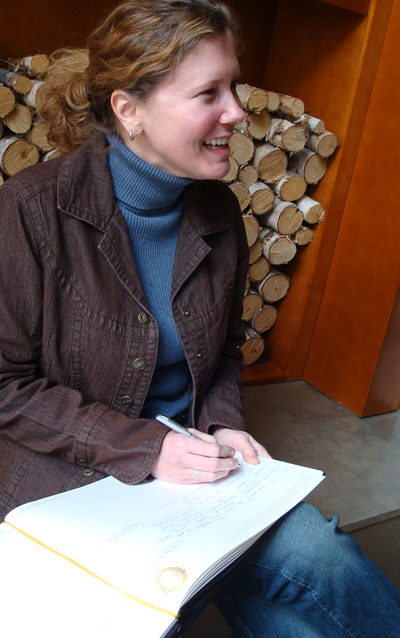
Among the strategies for meeting AccessComputing objectives for serving veterans is a Community of Practice (CoP) for veteran stakeholder groups. Communicating using email and other electronic tools, CoP members share perspectives and expertise, and identify practices that promote the participation of veterans with disabilities in postsecondary education and careers, including those in computing and IT fields. Collaborators can also receive support from AccessComputing staff in making their project activities more accessible (e.g., assistance in the design of an accessible website, suggestions for recruiting and accommodating veterans with disabilities).
The AccessComputing Veterans CoP is populated by veterans with disabilities, service providers, and volunteer mentors. Members
- interact regularly to improve service to veterans with disabilities and their families
- discuss how to recruit veterans with disabilities and accommodate them in their programs and activities
- devise solutions that increase the accessibility of their program offerings
- develop internships, academies, and workshops to complement their program activities
- identify, recruit, and accommodate eligible AccessComputing participants
- co-sponsor events, discuss potential projects, and share funding possibilities
- help plan and recruit participants for CBIs
- share common concerns in their practices
- identify problems, goals, and resources
- assess change
- form collaborations
To join the Veterans CoP, send the following information to doit@uw.edu and express your interest in joining the Veterans CoP:
- Name
- Position/Title
- Institution
- Postal address
- Email address
AccessComputing Website and Searchable Knowledge Base (AccessComputing: Building Capacity for Veterans 2009)
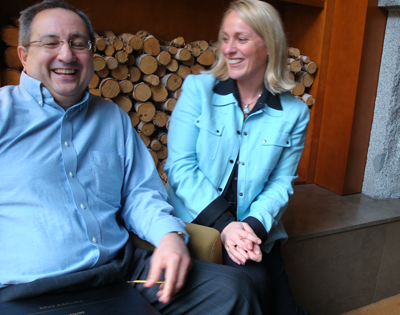
The AccessComputing website contains:
- information about project goals
- the application of evidence-based practices toward project deliverables
- resources for students with disabilities
- educational materials for postsecondary faculty and staff
- information about partners and collaborators
- program applications
DO-IT maintains a searchable database of frequently asked questions, case studies, and promising practices related to how educators and employers can fully include students with disabilities in computing activities.
The Knowledge Base can be accessed by following the "Search AccessComputing Knowledge Base" link on the AccessComputing website.
The Knowledge Base is an excellent resource for ideas that can be implemented in programs in order to better serve students with disabilities. Individuals and organizations are encouraged to propose questions and answers, case studies, and promising practices. In particular, the promising practices articles serve to spread the word about practices that show evidence of improving the participation of people with disabilities in computing. Contributions and suggestions can be sent to doit@uw.edu.
Examples of Knowledge Base questions include the following:
- How can I make my computing department more accessible to students with disabilities?
- Universally Designed Webpages: A Case Study on Access Issues for a Student with a Learning Disability
- What adaptive technology is typically provided to students with disabilities on postsecondary campuses?
- What are specific computer applications that can assist students with learning disabilities?
- Are there any web-based tutorials on web accessibility?
- How can principles of universal design be used to construct a computer lab?
Acknowledgments (AccessComputing: Building Capacity for Veterans 2009)
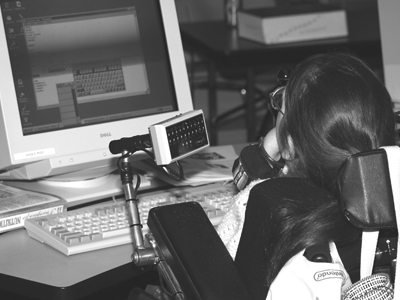
AccessComputing capacity building activities are funded by the National Science Foundation (grant #CNS-0540615 and #CNS-0837508). They were coordinated by the Alliance for Access to Computing Careers, which is led by the Department of Computer Science and Engineering and DO-IT at the University of Washington. Any opinions, findings, and conclusions or recommendations expressed in this material are those of the CBI presenters and publication authors and do not necessarily reflect the views of the National Science Foundation.
Some of the content of this publication is taken with permission from DO-IT. Permission is granted to modify and duplicate these materials for non-commercial purposes provided the source is acknowledged.
Electronic versions of this publication are available in print-ready and accessible formats at DO-IT.